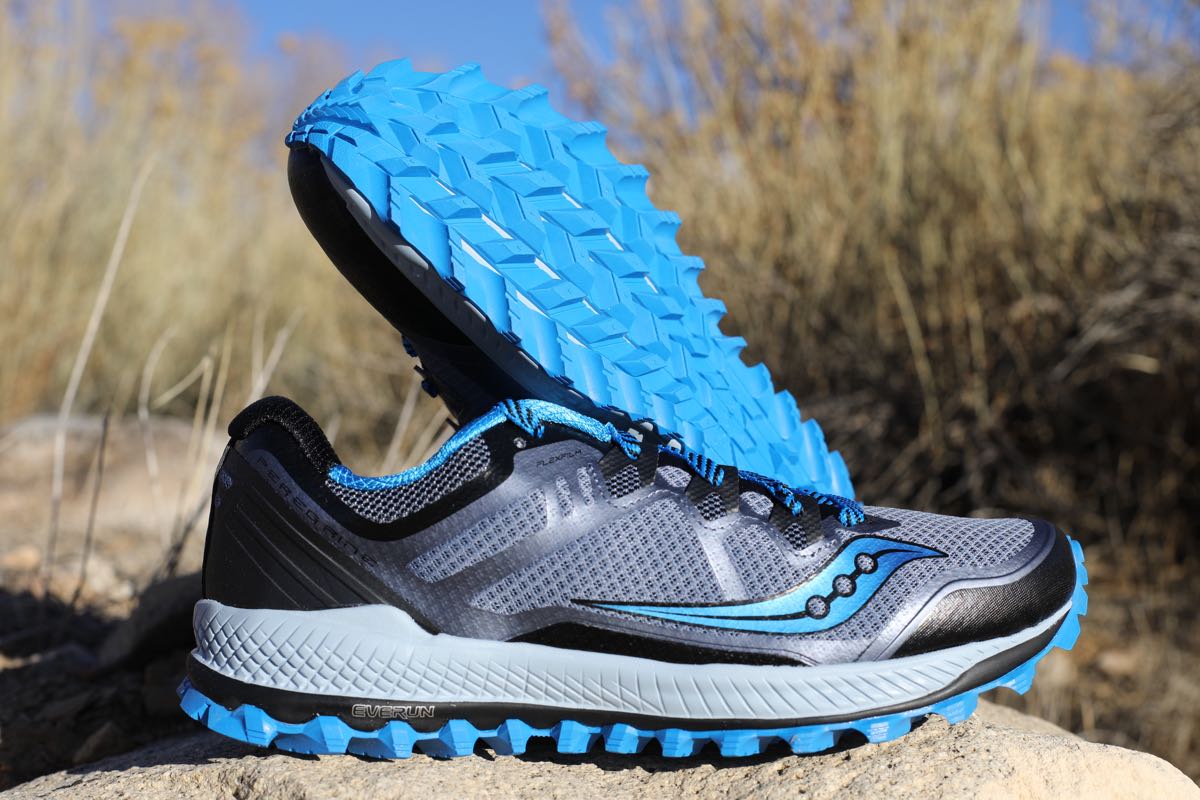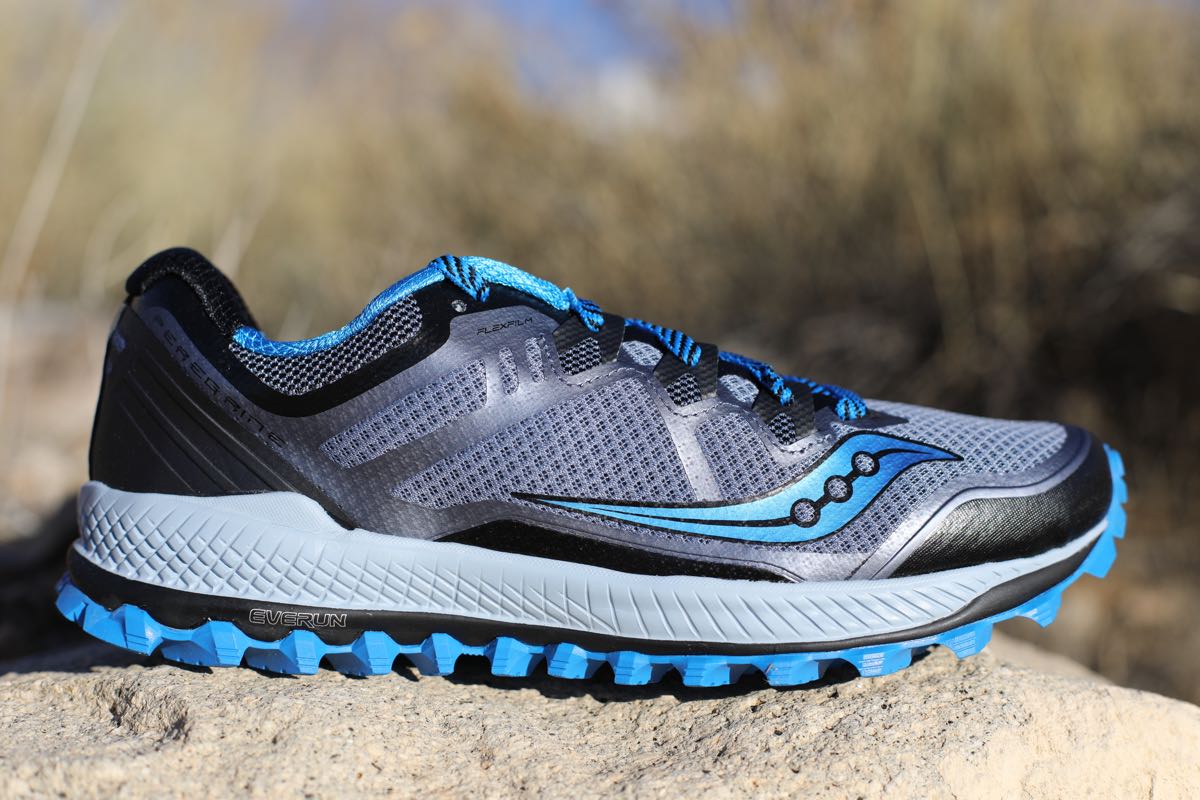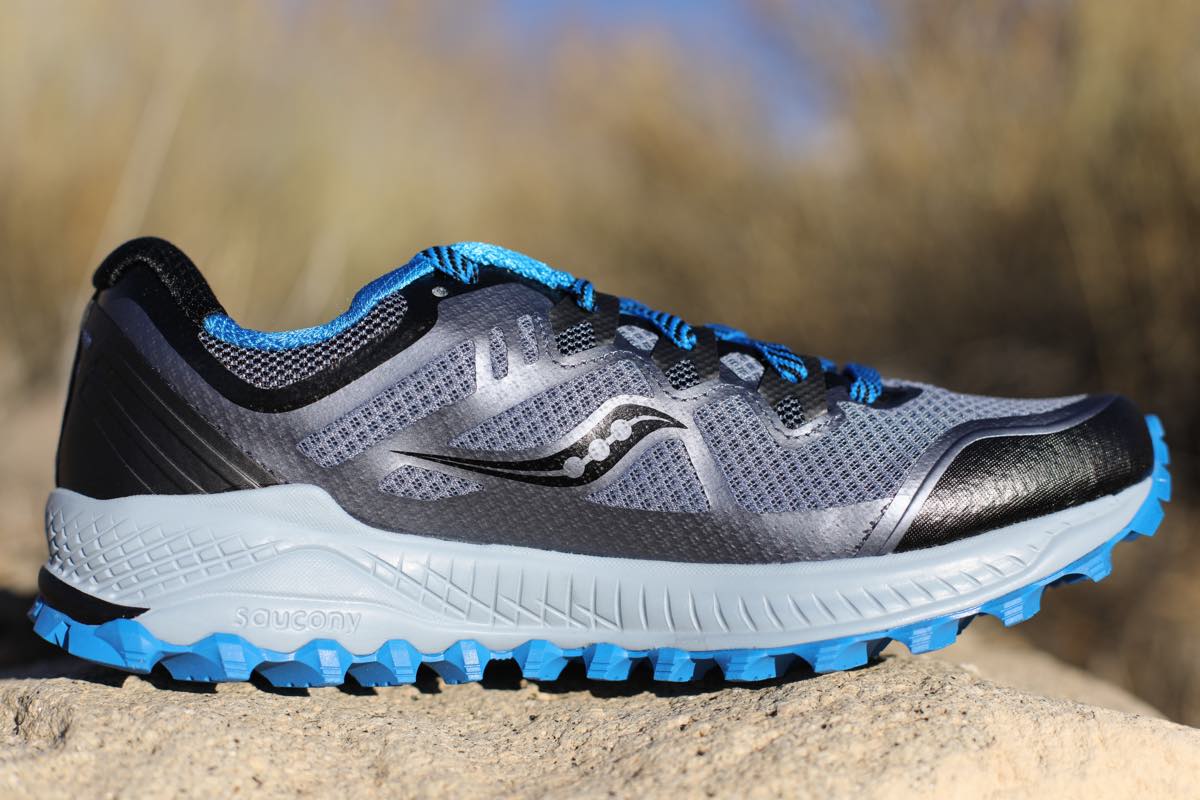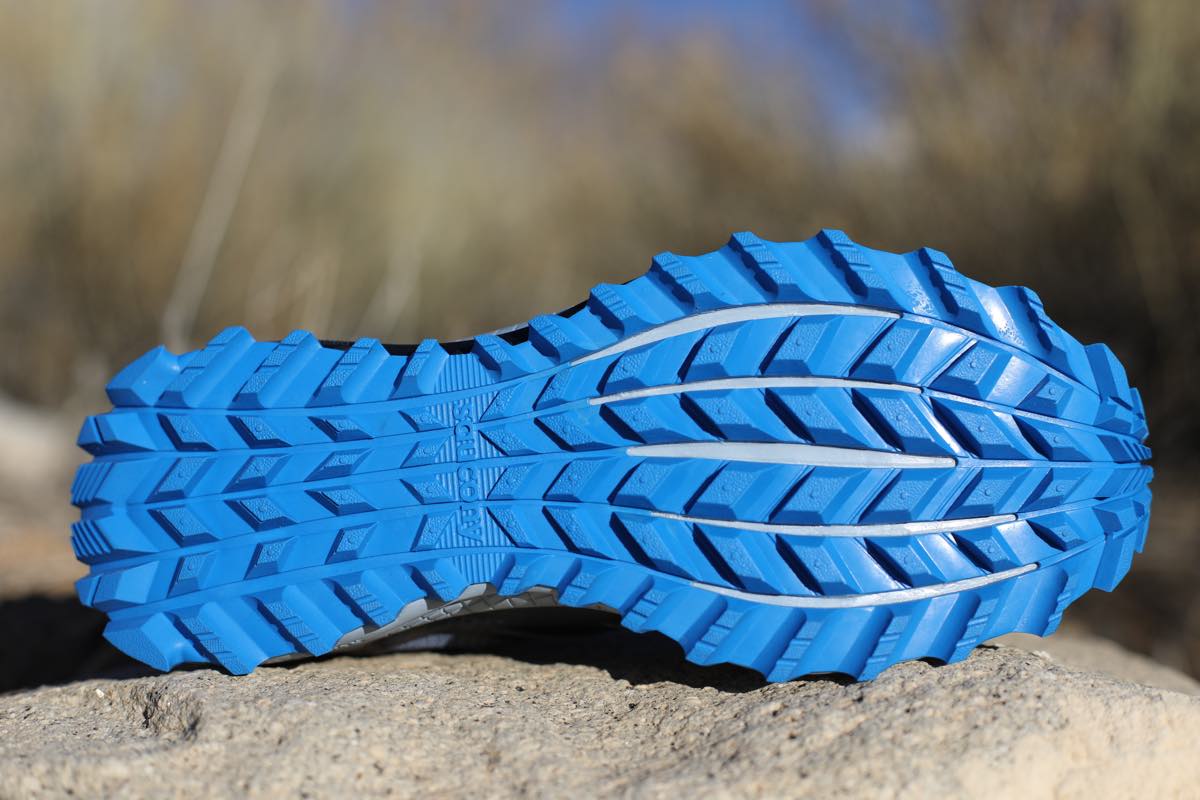For the latest on the Saucony Peregrine, check out our Saucony Peregrine 15 review.
Our Favorite Trail Running Shoes
Check out our Best Trail Running Shoes article to learn about our current favorite trail running shoes!
Saucony Peregrine 8 Review
To begin our review of the Saucony Peregrine 8 ($120), it’s meaningful to look back through this shoe model’s long history. The Peregrine stayed in a fairly predictable mold for the first five updates. There were the minor changes to be expected as a shoe moved from year to year. The update might include new color ways, perhaps some lighter material used here and there, or maybe some slight tweaks to the upper’s patterns in the name of support, but you could always count on the shoe staying close to its original design.
With the introduction of the Peregrine 6, we started to see a departure from that model. The Peregrine 7 continued to divert even more from the past and now with the latest iteration of the Peregrine 8, we have the most radical update so far. The upper shape is almost unrecognizable as being part of the Peregrine family and this toothy trail runner has lost its rock plate. Luckily one thing has held true that keeps this shoe connected to the past, an aggressive outsole and that low-to-the-ground 4-millimeter drop.
Are all of these changes enough to make a die-hard Peregrine wearer like myself think of moving on from this tried-and-true model? Check out the video below to find out.
[Editor’s Note: To look back at our previous Saucony Peregrine reviews: Peregrine 7 (2017), Peregrine 6 (2016), Peregrine 2 (2012), and the original Peregrine (2011).]
Saucony Peregrine 8 Review Transcript
The Peregrine, now in its eighth iteration, has seen quite a few changes over the years—none quite as drastic as what we saw with the 7 last year, maybe with the exception of what the 8 is this year. We maintain a really aggressive type of tread; we maintain that 4mm drop, and it’s roughly the same amount of weight coming in at around 10 ounces. Some of the biggest differences—the upper, the rock plate… the whole thing. We’ll get into details, and we’ll talk about that a little bit more.
What we’re looking at here are effectively all the major iterations of the Peregrine [showing three shoes]. Here in the middle we have the 5, which is the very classic design, very aggressive tread pattern. It started the Peregrine line with the 4mm drop. This was the model and the look and feel they kept for quite awhile until we moved up to the 6 and 7, which we have here and which is a fairly drastic update. You can see the mesh underneath these overlays over the top of it reducing stitching. It kind of changed the overall look and feel of the upper. But we still kept that really rugged outsole the Peregrine was known for and still kept that 4mm drop. They added in some things like this EVERUN top sole, which is a little cushier and a little bouncier but kept that PWRTRAC, which is what this stuff is called in the outsole. This shoe was always really good at that low-profile aggressive type of tread.
Saucony Peregrine 8 Upper
We move here into the 8, and you can see there are quite a few differences that exist here. Let’s start off by talking about this upper. If you are familiar with the Xodus or the Xodus ISO, which was another version of Saucony’s trail line, this upper is, in my opinion, really similar to that. It’s maybe a bit of a combination of the Xodus plus the previous versions of the Peregrine. As we look around here again, you’ll notice the lack of overlays, but there are some really nice strategic ones that help keep this shoe locked down to your foot. You have the lines coming from the back that pull on these tabs that allow this to lock down on your foot. I feel like the ankle area of this fits really similar to what we saw in the 7 with the addition of it being way more cushioned and less aggressive. That was one place where previous versions of Peregrines were really hard on some people’s heels or it took a little bit for it to break in. While still structured, this one is a much looser, much more padded heel collar than what we had before. It maintains the gusseted tongue, so it has that nice sock-like fit, and just all the way around updates, mesh, easier to drain, and just a more streamlined looking and, in fact, less-constrictive type of shoe. The 7 didn’t really give you a lot of room to wiggle your toes because of all those overlays on the upper.
Now, one of the places where that was really beneficial was in these wear zones. This shoe has about 100 miles on it, and you can see here, we’re starting to get some wear already, and on this side we’re starting to get some wear already. That’s something I’m going to have to look out for as I use this because 100 miles for this shoe to be falling apart is not ideal.
So, it’s a really nice upper though besides the wear area—good fit, don’t feel like I slide around a lot, more toe room than the previous one. The shoe locks down really good in the midsole and around the foot for a nice, good feel especially when you’re doing things like cornering or barreling downhill or whatever. It was able to lock in really well. The other thing I’ll note here is the sock liner. You can see this one is kind of muddy and dirty. That’s because it’s been a wet, sloppy mess here the last week or so in the Portland[, Oregon] area, and I’m happy to report that at least in my few really, really wet runs, this thing is not falling out and sliding all over the place. That’s a definite upgrade from the past version where I actually put Shoe Goo on them to glue them down to the insole to keep them from sliding. So far, that has not been a problem. I’ve gone about four hours in these in the wet and not had that as an issue.
Saucony Peregrine 8 Midsole
Let’s flip over to our midsole here. This is a neutral shoe with a 4mm drop. This is Powerfoam, which is all along the midsole, so there are not any blocks or pronation-control devices. This is listed as a neutral shoe. It’s good cushion. It’s good general cushion that I felt like provided plenty of cushion, responsiveness on road, trails, rocky sections, mud, and a little bit of everything. This shoe, to me, is a good all-arounder in terms of that. It doesn’t feel sluggish. It doesn’t feel sloppy. It’s firm enough to run fast, but there’s enough cushion there that you don’t feel like you’re taking a beating specifically in rocky sections.
Saucony Peregrine 8 Outsole
With that in mind, as we flip over here to the outsole, one of the things I want to point out is that there is a major amount of flexibility that’s been added to this version of the Peregrine. Just for a quick example, you can see me push my hand in and that shoe actually sinks in. I think to even show that more, I can do a simple twist here and squeeze, and this shoe is very flexible in the midfoot. Compare that to our previous version where I can’t really do anything. You’ll also note that in here [showing version 7] we have a rock plate, and in here [showing version 8] we do not. It’s less protective, and you do notice it, not a bunch, but it is noticeable comparatively. The pro to that is that this shoe feels way grippier and way less rigid. I feel like when I’m on some terrain that has me moving around a lot, this thing grips better. I’m going to assume it’s because my foot has a little bit more control over being able to dig in versus being on a much harder platform—so pros and cons there, right?
The last thing I want to talk about is the thing that I think makes the Peregrine a Peregrine and that is this aggressive outsole. It is 6mm rubber lugs called PWRTRAC. You can see there are the uphill lugs, the downhill lugs for braking and descending, and all that kind of stuff. They are a little bit deeper—they are 6mm lugs—and more flexible. So when you look at them, you can hopefully see from my hand here that these move around, and I feel like this is a drastic improvement. One of the things in the previous Peregrine lines that was always a little bit sketchy was being on slick, hard surfaces. You’d slide around because they didn’t have a lot of give in those lugs. They were hard, so it was like something hard on top of something else hard. It created a skating thing, which was not always fun when you encountered those types of obstacles. Because these are a lot more flexible, they sort of diffuse out, they give you a little more grip. They kind of smoosh, if you will, which adds a little more surface area and makes them grip a lot better.
Saucony Peregrine 8 Overall Impressions
In closing, this is a great shoe. This is the type of shoe I can just throw in my car, keep with me all the time, and whether I’m running some road, some really aggressive trail, some groomed trail, rocks, you name it, this is a pretty good shoe for all of those things. The lack of a rock plate, it’s somewhat noticeable, but man, it’s been very, very minimal compared to what I thought it would be. The biggest thing for me is durability, and this seems to be an ongoing issue with lots and lots of trail running shoes I’ve been trying lately. These pinch points up front just keep getting fried even really, really early on with mileage. That’s my ding on it. Overall, it’s a better fit than the 7. It’s more flexible. I feel like it’s more stable. I’m not rolling my ankles. I just feel like it’s a better, grippy, put-together shoe than what the last iteration was. It will probably be comfortable for a lot more people because of the changes they’ve made.
Questions, comments? Leave those below. Thanks for watching. We’ll catch you next time.
Call for Comments (from Meghan)
- What are your thoughts on the Saucony Peregrine 8 overall? And how would you compare it to previous versions that you’ve tried?
- For you Peregrine devotees, what do you think about the significant updates to version 8, especially the flexibility of the midfoot and forefoot as well as the lack of a rock plate?
[Editor’s Note: If you’re affiliated (i.e., an employee, ambassador, etc.) with a shoe brand, please share your relation in each of your comments on this article. Thanks!]





